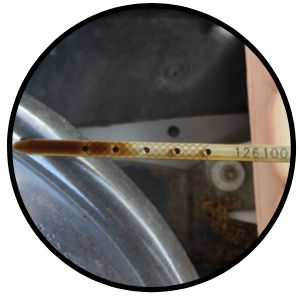One of the most common car issues is when it is leaking oil. Determining where and how it is losing oil in itself is half the battle. Fixing the oil leak should be considered a high priority.
There is a difference between losing oil and an oil leak. If there is no oil visibly leaking from the engine anywhere, but the oil level is dropping over time, your engine is “using” oil. That means that it is finding its way into the combustion chamber and out of the tailpipe.
Car Leaking Oil Symptoms
Here are the main symptoms of a vehicle that is leaking oil:
- Oil Under the Car– The most obvious symptom of an oil leak is the little puddle of oil or the dots that you’ll find on your garage floor. Transmission fluid and power steering fluid could also have leaked. Check all of their levels. If the power steering fluid looks low or foamy, it may be a power steering leak that you are looking at. If the fluid on the garage is red in color (which is almost always the color of transmission fluid) it may be a transmission fluid leak that you are looking at.
- Oil on Engine– The oil has to be getting out from somewhere. Before it lands on the driveway it has to leak on the engine. Where it’s coming from is the question. We’ll go into that in the next section (most of the time it’s the valve covers).
- Smoke Under the Hood– If oil is leaking from the right spot, it can leak onto the exhaust manifold(s) and it gets smokey. It’s not nearly as flammable as transmission fluid. All it usually does is smoke and stink.
Oil Leak Causes
Fixing an oil leak means determining where it is coming from and repairing the issues. Depending on where it is leaking from, the repair can be very challenging or relatively easy. This is a list of likely places that the oil could be leaking from your car, and is presented in order from easiest to most difficult to repair.
- Oil Filter– If the oil filter has been damaged or wasn’t sealed properly at the last oil change, it very well could be leaking some oil.
- Oil Plug– If the oil plug has been stripped out or was left loose, oil could be getting through it and onto the driveway.
- Valve Cover Gasket– The valve cover gasket(s) are a very common place for oil to leak from. Depending on where exactly the valve cover the oil is leaking from will have an impact on other parts of the vehicle. For instance, if the oil is leaking from the valve covers above the exhaust, it’ll burn and smell as you drive. If the oil leaks from the valve covers oil on spark plugs, it can cause problems with the ignition system.
- Oil Pan– The oil pan is a very common place for oil to leak from. Most likely, the gasket that sits between the oil pan and the engine block will go bad. But, it’s not unheard of for an oil pan to crack or get a hole in it. In order to fix an oil leak coming from the pan area, it’s going to take a lot of time, skill, and patience.
How to Fix an Oil Leak
If the oil leak is coming from the oil filter or plug, clearly replacing them is going to be the fix. If you do end up changing the plug or oil filter, just make sure to get new oil when you go to the parts store, since you’ll end up losing the engine oil when dealing with either one.
If the oil is leaking from the valve cover area, get the torque specs and see if tightening them up will fix the problem. If it does not, you’ll need to go ahead and replace the gasket. The same exact plan of attack will work for the oil pan gasket. But, of course it’s much more difficult to get down there and tighten these bolts. Be careful under your car and use ramps or jack stands. Never get under only with a floor jack.
Conclusion
It can be tough finding an oil leak, particularly with how tight and cramped today’s modern engine compartments are. Good luck with the diagnosis. If there is anything that you would like to add, please feel free to leave a comment below.


